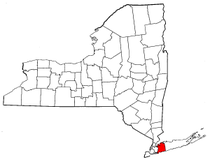Early Nassau & Suffolk County History

Nassau County
There were claims and counterclaims. A Scotchman claimed Long Island, according to Van der Donck. Another, Captain Andrew Forester, of Dundee, claimed Long Island for the Dowager of Sterling. When Charles II ascended the throne, Winthrop, Governor of the colony of Connecticut, was sent to England to obtain a charter. He received a charter covering the territories of the colonists of Connecticut and New Haven, and as a result the colony which became later known as the Connecticut Colony laid claim to Long Island, as being one of the islands adjacent. The English Settlement In 1664 Major John Scott came to Long Island with some royal authority and formed a combination of the Englishes (sic) villages Hempstead, Gravesend, Flushing, Newtown, Jamaica, and Oyster Bay with himself as president.From the time of the earliest settlement on Long Island until the surrender of the colony of New Netherland to the English the western end of the island was within the jurisdiction of the Dutch, whose claim included the town of Oyster Bay, which claim, however, was disregarded by the English. The Plymouth Company issued, by order of Charles I, letters patent to William, Earl of Sterling, for the entire island. Sterling executed a power of attorney to James Farrett to dispose of lands on Long Island. Four years later the earl died and his grandson, who succeeded him, survived but a few months. Their heirs surrendered the grant for the island to the Crown. The settlers on the eastern end were left to themselves and regulated their affairs accordingly. Purchases of land were made by the towns and were in later years confirmed by the governors appointed by the Duke of York.
Charles II granted, by letters patent, to his brother James, the country occupied by the Dutch, together with Long Island. Lyon Gardiner appears to have been the first settler on the eastern end of the island, locating on Gardiner’s Island a little before Southold and Southampton were settled. Then came the settlements of Easthampton, Shelter Island, Oyster Bay, Huntington, Brookhaven, and Smithtown. Each town was in the beginning a colony by itself, independent of all others. After a few years the towns voluntarily placed themselves under the protection of the New England colonies. Southampton obtained the protection of Connecticut; Easthampton, Brookhaven, and Huntington did the same thing later. Southold united with the New Haven colony, together with Shelter Island. When the colonies of New Haven and Connecticut were united and a new charter was granted, including the territory of the islands adjacent, Connecticut claimed Long Island as one of those islands, and this claim had the support of the eastern towns. Oyster Bay also placed itself under the protection of Connecticut.
The other English towns on the western end, within the Dutch jurisdiction, were trying to join this union, and then the grant to the Duke of York was made, and at the same time the colony of New Netherland became English, and Long Island was incorporated with New York. Later the English Governor called together delegates of the various towns to meet at Hempstead. At this assemblage Long Island and Staten Island were created into a “shire” called Yorkshire, and the Duke’s laws were formulated. Yorkshire was divided into three ridings like its namesake in England. These were divisions of territory for the convenience of the courts. The shires in England were also called counties, because they were governed by a count or earl.
The several towns had up to this time existed without having their boundaries properly fixed. The settlers of the district came together from time to time to regulate their local affairs, and these men, associated for the purpose of government, constituted the town. Now the towns were recognized and were required to take out patents for the lands within their boundaries, which the towns themselves, or the West India Company, had purchased from the Indians. The present Suffolk County had constituted the East Riding, Hempstead, Flushing, Jamaica, and Oyster Bay the North Riding, and the present Kings County, Newtown, and Staten Island, the West Riding. The first General Assembly of the colony met and repealed some of the Duke’s laws. The ridings also were abolished and the island was redivided into three counties – Kings, Queens, and Suffolk. The town of Newtown, formerly a part of West Riding, was made a part of Queens County. Kings and Queens counties were named in compliment of King Charles and his wife. Staten Island was made a county by itself and named Richmond, one of the titles of a son of Charles.
In 1788 the towns were recognized by the laws of the newly established State of New York. The division of the island into three counties remained in force until Greater New York City came into existence, taking in, among Long Island territory, Kings County and a large part of Queens County. In 1899 Queens County was divided. The part included within the greater city retained the old name, and the remainder was incorporated as the county of Nassau.


